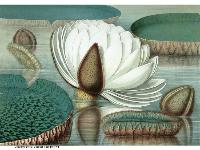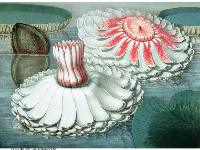 VICTORIA REGIA,
VICTORIA REGIA,OR
THE GREAT WATER LILY
OF
AMERICA.
WITH ILLUSTRATIONS BY WILLIAM SHARP,
FROM SPECIMENS GROWN AT SALEM, MASSACHUSETTS, U. S. A.
BY JOHN FISK ALLEN.
BOSTON:
PRINTED AND PUBLISHED FOR THE AUTHOR,
BY DUTTON AND WENTWORTH, 37 CONGRESS STREET. 1854.
( Color Images © The University of Kansas Spencer Museum of Art - Click to enlarge )
|
These images from 1854 were drawn on stone and printed by Sharp, America's first chromolithographic printer. This was the earliest example of large scale color printing in the United States. |
||
 Plate 1 |
This is an illustration of the first two cycles of the growth of the lily; at the twelfth page the diary of this can be found. The left hand drawing represents the plant when the first cycle of five leaves is completed, every successive leaf being larger than its predecessor. The right hand figure exhibits the plant when the second cycle is completed. This is the mode of its growth; a continued repetition of the cycle of five leaves, with a steady advance in their size until the maximum one, which usually is the twenty-seventh or twenty-eighth, is produced, when, if the plant is in health, the last-named leaf is accompanied by the flower-bud. |
|
|
After the plant has commenced flowering the first year, the successive leaves do not enlarge, but remain of the same size, or diminish gradually as the sun withdraws to the south; increasing again as it returns to the north in the spring. These leaves do not grow regularly from left to right, but they follow what is called the five-ranked arrangement. What this is can be seen by the drawings; every successive leaf in the growing plants being larger than the previous one. On the right hand figure the smallest leaf is the sixth which the plant made, and this grew directly over the first, or simple spear, like a shoot of grass. On the third cycle, the eleventh leaf appeared over the sixth, and every leaf throughout is true in its growth to this arrangement. When a plant is in deep water this cannot be ascertained. In two plants grown in shallow water, and afterwards placed in deeper, we have been able to notice this. On a third, where the seed was sown at a depth of five feet, nothing of its growth was observable before the fourth shoot; the first leaf which floated upon the surface came up. Under ordinary circumstances the three first shoots do not come to the surface; if the seed should vegetate in only two or three inches of water, probably they would. Upon the plant sown in deep water, the first leaf which floated extended its stem six or eight feet to bring it to the surface, whereas on those in shallow water, they attained but a small portion of that length, thus indicating with what ease it adapts itself to its position. A matured plant will grow the petiole upwards of fifteen feet, if sufficient room is provided. The bud which should produce the eleventh leaf is not represented in the drawing; coming as it does directly over the first and sixth shoots, it would have interfered with the proper showing of the latter. This leaf-bud is folded up closely, when it first appears on the surface side, presenting a slight induration. This folding may be explained thus; --close the hands by placing the fingers upon the palms of each, separately, let the thumbs fall naturally upon the fingers, bring the closed hands together, the wrists touching firmly and the fingers loosely; the slight opening between the fingers of each hand may be considered as corresponding to the lines of the ribs, wanting the cross line; this suture between the hands representing the induration at the centre, where the unfolding of the leaf has begun. By extending the thumbs upwards somewhat, and closing the hands firmly at the wrists at the same time, slowly opening the fingers upwards, outwards and downwards, the process of unfolding can be seen. The outside of the bud constitutes the under and ribbed side of the leaf, as shown in plate third. |
||
 Plate 2 |
The second plate is a representation of portions of the leaves of a matured plant, with the expanding flower of the actual size, as described on the twelfth page. An opening or unfolding leaf, with a leaf-bud just emerging above the water, with the accompanying flower-buds, is a partial view of the plant as mentioned at the ninth and thirteenth pages. The largest leaf measuring 71 to 72 inches in diameter, with eight leaves of different sizes. The small size of the tank rendering it necessary to remove the older ones to make room for those expanding. In its native waters five leaves is named as the maximum number found upon a plant, and it does not appear that more than ten can be maintained in health under cultivation in the latitude of Boston. |
|
 Plate 3 |
The third plate is a drawing of the underside of the leaf. It will be remembered that the shape is nearly round. This is in perspective, that the wonderful mechanism may be the better shown. | |
 Plate 4 |
The fourth plate shows the flowers, during the intermediate stages, as mentioned at pages nine and thirteen. But they continue in these forms a short time only. Advantage has been taken here to show the curious sporting habit in the various markings of the crimson. These, with the full blown flower, as shown in plate fifth, being correct illustrations of the earliest flower; as mentioned on the ninth page, and also in Mr. Meehan's communication on the eleventh page. | |
 Plate 5 |
Plate fifth is the full blown flower, or just completing the bloom, as the stamens have yet to unfold somewhat in the centre. The bud nearest the flower is represented as it appears usually the day before unfolding, rather more advanced than it would be seen at this time. A fruit is also shown here, having risen to the surface after perfecting its seed. To make the illustrations as complete and varied as possible, without adding too much to the cost by a multiplication of the plates, has been the governing motive in their arrangement. |
|
 Plate 6 |
Plate sixth is a view of the form of the flower mentioned at the thirteenth page, being that of the sixth and seventh which expanded on the plant at Salem. The cause of this sport cannot be determined, earlier and later flowers expanding fully. | |